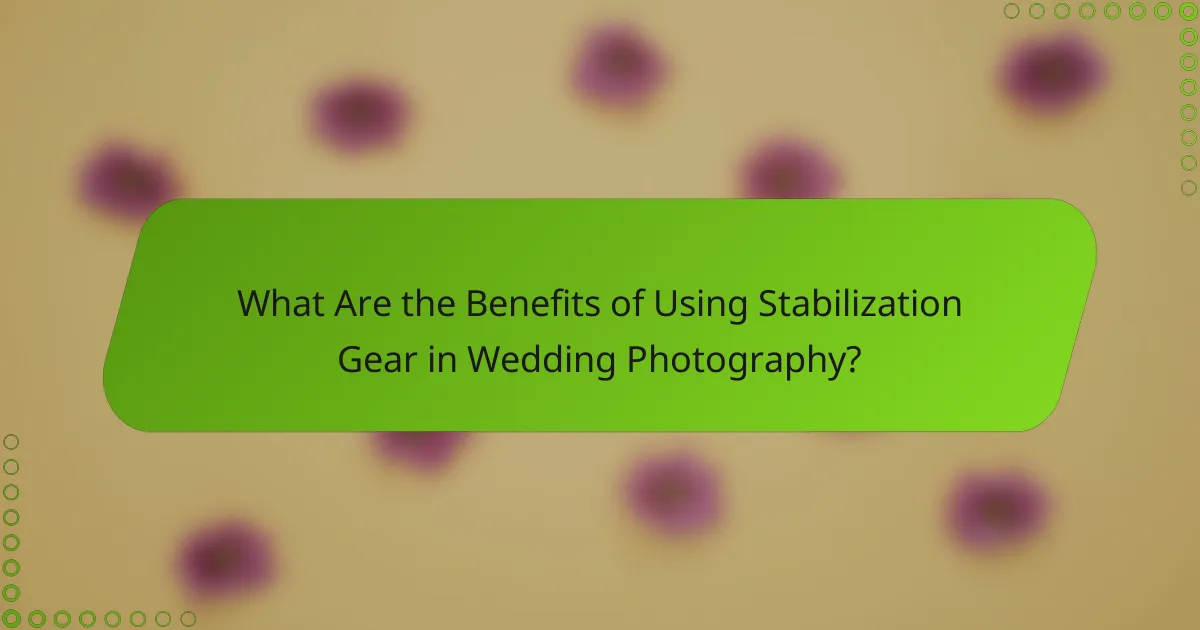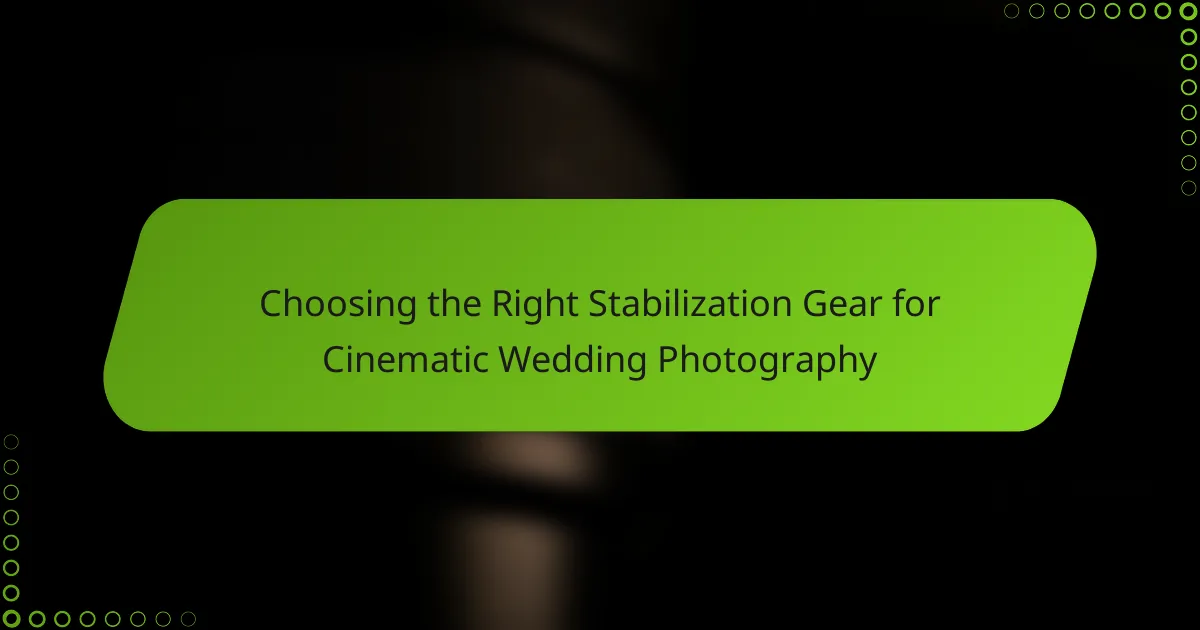Choosing the right stabilization gear is crucial for capturing cinematic wedding photography that looks polished and professional. Options such as gimbals, steadicams, and handheld stabilizers each provide distinct advantages, allowing you to achieve smooth footage during the dynamic moments of a wedding. When making your selection, consider factors like weight capacity, battery life, and portability to enhance both the quality of your shots and your shooting experience.

What Are the Best Stabilization Gear Options for Wedding Photography?
The best stabilization gear for wedding photography includes gimbals, steadicams, shoulder rigs, tripods, and handheld stabilizers. Each option offers unique benefits, helping to achieve smooth, professional-looking footage during dynamic events like weddings.
Gimbals: DJI Ronin-S
The DJI Ronin-S is a popular gimbal choice for wedding photographers due to its lightweight design and advanced stabilization technology. It features a 3-axis motorized system that effectively counters unwanted camera movements, ensuring smooth shots even while walking or moving quickly.
When using the Ronin-S, consider its compatibility with your camera setup and battery life, which typically lasts around 12 hours. This gimbal is ideal for capturing dynamic moments, such as the couple’s first dance or candid interactions during the ceremony.
Steadicams: Glidecam HD-Pro
The Glidecam HD-Pro is a versatile steadicam that allows for fluid motion capture, making it suitable for wedding photography. It requires a bit of practice to master, but once you do, it can produce stunningly smooth footage, especially in crowded or fast-paced environments.
When using a steadicam like the Glidecam, focus on balancing your camera properly to avoid fatigue and ensure optimal performance. This gear is particularly effective for capturing long sequences, such as the wedding procession or reception activities.
Shoulder Rigs: Neewer Shoulder Mount
The Neewer Shoulder Mount provides a stable shooting platform that distributes the camera’s weight evenly across your body. This rig is beneficial for extended shooting sessions, allowing you to maintain comfort while capturing various angles during the wedding.
Shoulder rigs are excellent for low-angle shots or when you need to move quickly through a venue. Ensure that the rig is adjustable to fit your body type, and practice using it to improve your shooting technique and stability.
Tripods: Manfrotto Befree
The Manfrotto Befree tripod is a compact and lightweight option ideal for wedding photographers who need stability without bulk. This tripod is easy to set up and adjust, making it perfect for capturing static shots during key moments, such as the ceremony or speeches.
When using a tripod, consider the venue’s space and lighting conditions. A sturdy tripod can help you achieve long exposure shots in low light, but be mindful of its placement to avoid obstructing guests’ views.
Handheld Stabilizers: Zhiyun Crane 2
The Zhiyun Crane 2 is a handheld stabilizer that combines portability with advanced stabilization features. It allows for smooth, dynamic shots while remaining easy to maneuver, making it a great choice for capturing spontaneous moments during a wedding.
This stabilizer supports various camera sizes and weights, so check compatibility with your equipment. The Crane 2 also offers multiple shooting modes, enabling you to adapt to different scenes, from intimate close-ups to wide-angle group shots.

How to Choose the Right Stabilization Gear for Weddings?
Choosing the right stabilization gear for weddings is crucial for capturing smooth, cinematic footage. Key factors include the weight of your camera, your shooting style, budget, and compatibility with your equipment.
Consider Camera Weight
The weight of your camera significantly impacts the type of stabilization gear you should select. Lighter cameras may work well with handheld gimbals, while heavier setups might require more robust stabilizers like steadicams or larger gimbals. Always check the weight limits of your chosen stabilizer to ensure optimal performance.
When evaluating camera weight, consider the total setup, including lenses and accessories. A camera rig weighing around 2-3 kg typically pairs well with mid-range gimbals, while heavier rigs may necessitate professional-grade stabilization systems.
Evaluate Shooting Style
Your shooting style plays a vital role in determining the best stabilization gear. If you frequently move while filming, a gimbal may be your best option for smooth motion. Conversely, if you prefer static shots or minimal movement, a tripod or monopod might suffice.
Consider the types of shots you plan to capture during the wedding. For dynamic scenes like the couple’s first dance, a gimbal provides fluidity, while for speeches or ceremonies, a tripod ensures stability and focus.
Assess Budget Constraints
Budget constraints can greatly influence your choice of stabilization gear. High-quality gimbals and steadicams can range from a few hundred to several thousand dollars. Determine how much you are willing to invest based on your needs and the potential return on investment.
It’s wise to allocate funds not only for the stabilizer itself but also for any additional accessories, such as batteries or counterweights. A budget of around $300 to $800 can secure a reliable gimbal suitable for wedding photography.
Check Compatibility with Camera Models
Ensuring compatibility with your camera models is essential when selecting stabilization gear. Many stabilizers are designed to work with specific brands or models, so verify the manufacturer’s specifications before making a purchase.
Look for stabilizers that offer adjustable mounting options or come with various camera plates to accommodate different setups. This flexibility can save you from needing to buy new gear if you upgrade your camera in the future.

What Are the Key Features to Look for in Stabilization Gear?
When selecting stabilization gear for cinematic wedding photography, focus on weight capacity, battery life, ease of use, and portability. These features significantly impact the quality of your footage and the overall shooting experience.
Weight Capacity
The weight capacity of stabilization gear determines how much camera equipment it can support. Most stabilizers can handle a range from a few hundred grams to several kilograms, so ensure your chosen gear can accommodate your camera and lens setup comfortably.
For example, if you plan to use a DSLR with a heavy lens, look for stabilizers rated for at least 2-3 kg. This will prevent strain on the motor and ensure smooth operation.
Battery Life
Battery life is crucial for long wedding shoots, where you may not have frequent access to charging. Many stabilizers offer battery life ranging from 6 to 12 hours, which is generally sufficient for a full day of shooting.
Consider models with removable batteries for quick swaps during events. Always check reviews for real-world performance, as advertised battery life can sometimes differ from actual usage.
Ease of Use
Ease of use is essential, especially in fast-paced wedding environments. Look for stabilizers with intuitive controls and quick setup features, allowing you to transition between shots smoothly.
Some models come with preset modes for different shooting styles, which can save time. Practice with the gear before the event to familiarize yourself with its operation and settings.
Portability
Portability affects how easily you can transport your stabilization gear to various wedding venues. Lightweight and compact designs are preferable, especially if you need to move around frequently.
Consider stabilizers that fold down or come with carrying cases. This will help you manage your gear efficiently without adding unnecessary bulk to your photography kit.

How Do Different Stabilization Gears Compare for Wedding Use?
Different stabilization gears serve unique purposes in wedding photography, impacting the quality of footage captured. Understanding their strengths and weaknesses helps photographers choose the right equipment for smooth, cinematic shots.
Gimbal vs Steadicam
Gimbals use motors to stabilize the camera, allowing for fluid motion even during movement. They are often lighter and easier to use for long periods, making them ideal for dynamic wedding environments.
Steadicams, on the other hand, rely on a counterweight system to balance the camera. While they can provide excellent stabilization, they may require more practice to master and can be heavier, which might lead to fatigue during lengthy events.
Shoulder Rig vs Handheld Stabilizer
Shoulder rigs distribute the weight of the camera across the shoulder, providing stability and comfort for extended shooting sessions. They are particularly useful for capturing steady shots while moving through crowded venues.
Handheld stabilizers, while compact and portable, may not offer the same level of stability as shoulder rigs. They are best suited for quick shots or when space is limited, but can lead to shaky footage if not used carefully.
Tripod vs Gimbal
Tripods provide a stable base for static shots, making them perfect for capturing vows or speeches without any movement. They are generally more affordable and easier to set up, but lack the versatility needed for dynamic shooting.
Gimbals, in contrast, allow for smooth motion while filming, making them ideal for capturing the energy of the day. However, they require more setup time and can be more expensive, so consider the type of shots you want to prioritize when making your choice.

What Are the Benefits of Using Stabilization Gear in Wedding Photography?
Using stabilization gear in wedding photography significantly enhances the overall quality of both video and still images. This equipment helps to eliminate unwanted shakes and jitters, allowing for smoother, more professional-looking footage that captures the essence of the event.
Improved Video Quality
Stabilization gear, such as gimbals and steadicams, plays a crucial role in improving video quality by providing a stable platform for capturing footage. This stability reduces motion blur and shaky shots, resulting in a more polished final product. For wedding videographers, this means smoother pans and tracking shots that can elevate the storytelling aspect of the wedding film.
When selecting stabilization gear, consider the weight and balance of your camera setup. A well-balanced rig can make a significant difference in achieving high-quality footage, especially during dynamic moments like the couple’s first dance or the ceremony processional.
Enhanced Creative Shots
Stabilization gear opens up a range of creative possibilities for wedding photographers and videographers. With the ability to move fluidly, you can capture unique angles and perspectives that would be difficult to achieve otherwise. For instance, using a gimbal allows for sweeping shots that follow the couple as they walk, creating a cinematic feel.
Experimenting with different stabilization techniques can lead to stunning results. Consider using low-angle shots or high sweeping movements to add drama and emotion to your wedding coverage. Always plan your shots in advance to maximize the creative potential of your stabilization gear.
Reduced Fatigue During Long Shoots
Long wedding days can be physically demanding, and using stabilization gear can help reduce fatigue for photographers and videographers. Equipment like shoulder rigs or handheld gimbals distributes weight more evenly, allowing for extended shooting periods without excessive strain on your arms and back.
To further minimize fatigue, practice good posture and take regular breaks. Investing in ergonomic gear can also make a significant difference, enabling you to focus on capturing the day without being hindered by discomfort.
